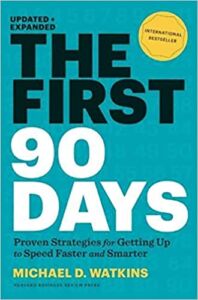My Top 10 Essential Leadership Books
My Top 10 Essential Leadership Books
Dr. Robert Solano
 As a leadership consultant and avid reader, I am often asked if there are any books that I recommend for aspiring leaders or seasoned executives. And every time I’m asked this question, I’m filled with emotion because I know how crucial good leadership is in both personal and professional life. It’s a responsibility that cannot be taken lightly, and the right book can make all the difference.
As a leadership consultant and avid reader, I am often asked if there are any books that I recommend for aspiring leaders or seasoned executives. And every time I’m asked this question, I’m filled with emotion because I know how crucial good leadership is in both personal and professional life. It’s a responsibility that cannot be taken lightly, and the right book can make all the difference.
But recommending books is not an easy task. It’s like prescribing medicine; it has to be tailored to the individual’s circumstances. The same book that can be a game-changer for one person might not be the best fit for someone else.
That’s why I have put together a list of the top 10 essential leadership books that, in my opinion, are 5-star books. These books cover a range of topics from communication, self-improvement, and team management, and are applicable to different stages of a leader’s journey.
While some books are more specific to certain situations, like “The First 90 Days” for new executives, others, like “How to Win Friends and Influence People” and “The Four Agreements,” are universal and applicable to all leaders.
My hope is that you will browse through this list and pick a few that resonate with you the most. Listen to your intuition, and select the book that you feel will help you grow the most as a leader. Trust me, every book on this list is excellent, and if you are receptive to the lessons they teach, they will undoubtedly make you a better leader.
Drive: The Surprising Truth About What Motivates Us
by Daniel Pink
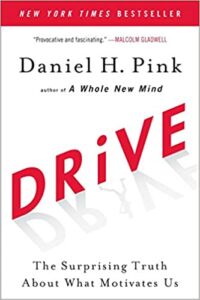 Daniel Pink’s book “Drive: The Surprising Truth About What Motivates Us” challenges traditional notions of motivation in the workplace. The author argues that the traditional approach to motivation – the carrot-and-stick approach – is no longer effective in today’s world, where creative and complex work is increasingly the norm.
Daniel Pink’s book “Drive: The Surprising Truth About What Motivates Us” challenges traditional notions of motivation in the workplace. The author argues that the traditional approach to motivation – the carrot-and-stick approach – is no longer effective in today’s world, where creative and complex work is increasingly the norm.
Pink suggests that the traditional approach fails to tap into what truly motivates people: a sense of autonomy, mastery, and purpose. Autonomy, or the desire to direct one’s own life, is a powerful motivator. Pink argues that organizations should give their employees more autonomy in their work, allowing them to make decisions about how to approach and solve problems. Mastery, or the desire to improve and master skills, is another key motivator. Organizations should provide their employees with opportunities to develop their skills and improve their performance. Finally, purpose, or the desire to make a meaningful contribution to the world, is a third key motivator. Organizations should align their employees’ work with a greater sense of purpose and meaning.
The key takeaways for business owners and leaders from this book are:
The traditional approach to motivation – the carrot-and-stick approach – is no longer effective for motivating people in today’s complex and creative work environment.
Autonomy, mastery, and purpose are powerful motivators that organizations should tap into to motivate their employees.
Giving employees more autonomy in their work, providing opportunities for mastery, and aligning their work with a sense of purpose can lead to higher performance and greater job satisfaction.
Leaders and managers should focus on creating a work environment that fosters autonomy, mastery, and purpose, and should recognize and reward employees who demonstrate these qualities.
Overall, “Drive” is an insightful and thought-provoking book that challenges traditional notions of motivation in the workplace. Business owners and leaders who want to improve employee motivation and performance should read this book and consider implementing the principles of autonomy, mastery, and purpose in their organizations.
Get “Drive: The Surprising Truth About What Motivates Us” here on Amazon.
Good to Great: Why Some Companies Make the Leap and Others Don’t
by Jim Collins
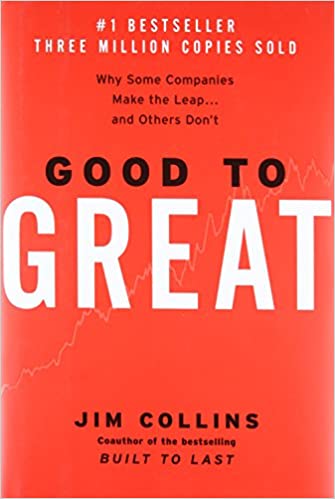 “Good to Great” by Jim Collins is a book that explores why some companies are able to transform themselves from good performers to great ones, while others fail to make the leap. Collins and his team of researchers spent five years studying 28 companies that had made the transition from good to great, and compared them to a control group of companies that had similar characteristics but didn’t make the leap.
“Good to Great” by Jim Collins is a book that explores why some companies are able to transform themselves from good performers to great ones, while others fail to make the leap. Collins and his team of researchers spent five years studying 28 companies that had made the transition from good to great, and compared them to a control group of companies that had similar characteristics but didn’t make the leap.
Key Takeaways for Business Owners and Leaders:
- Level 5 Leadership: The book argues that the most successful companies had leaders who were humble and focused on the success of the company rather than their own personal success. This type of leader is called a “Level 5 Leader” and is someone who blends personal humility with a fierce resolve to do what is best for the company.
- The Hedgehog Concept: The great companies all had a clear understanding of what they were best at and focused on it relentlessly. This concept is called the “Hedgehog Concept” and involves finding the intersection of three circles: what you are passionate about, what you can be the best in the world at, and what drives your economic engine.
- The Flywheel Effect: The book argues that great companies did not have a single defining moment, but rather a series of small wins that built momentum over time. This concept is called the “Flywheel Effect” and involves identifying key drivers of success and continually improving them to create a self-sustaining system of growth.
- The Importance of Culture: The book emphasizes the importance of creating a culture of discipline and a culture of freedom. A culture of discipline involves aligning the company’s goals, people, and processes towards a common purpose, while a culture of freedom involves empowering people to take risks and innovate within the framework of the company’s goals.
One other key lesson from the book, which deserves a more detailed summary is the importance of “getting the right people on the bus” as a crucial factor in transforming a good company into a great one. Collins argues that it’s not just about having talented individuals, but it’s about finding the right people who are aligned with the company’s vision and values. By getting the right people on the bus and in the right seats, a company can create a culture of discipline and focus on achieving its goals. This involves finding individuals who are not only capable but also have a passion for the company’s mission, as well as ensuring that everyone is working towards a common purpose. Without the right people, a company may struggle to achieve sustainable success, as it’s difficult to create a high-performance culture with the wrong individuals on board. Therefore, it’s important for business owners and leaders to prioritize getting the right people on the bus and aligning them with the company’s values and goals to achieve greatness.
“Good to Great” is a seminal book that is largely one of the most popular and well-recognized leadership books of the past two decades. It offers valuable insights for business owners and leaders who are looking to take their companies to the next level. By focusing on Level 5 Leadership, the Hedgehog Concept, the Flywheel Effect, and building a strong culture, and getting the right people “on the bus,” companies can create sustained success over the long term.
Get “Good to Great” here on Amazon.
Extreme Ownership: How Navy SEALs Lead and Win
by Jocko Willink and Leif Babin
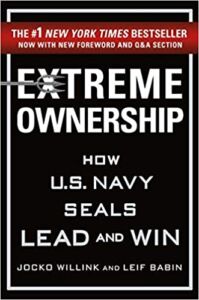 “Extreme Ownership: How Navy SEALs Lead and Win” by Jocko Willink and Leif Babin is a book about leadership and management based on the lessons learned by the authors during their service in the U.S. Navy SEALs. The book is a gripping account of their experiences leading Task Unit Bruiser in the Iraq War, and how they applied those experiences to the world of business.
“Extreme Ownership: How Navy SEALs Lead and Win” by Jocko Willink and Leif Babin is a book about leadership and management based on the lessons learned by the authors during their service in the U.S. Navy SEALs. The book is a gripping account of their experiences leading Task Unit Bruiser in the Iraq War, and how they applied those experiences to the world of business.
The key takeaway of the book is that leadership is the most important factor in the success or failure of a team, and that leaders must take full responsibility for the outcome of their team’s actions. The authors emphasize the importance of extreme ownership, which means taking full responsibility for everything that happens in one’s sphere of influence, and not making excuses or blaming others when things go wrong.
The book is structured around twelve principles of leadership, each illustrated with real-life examples from the authors’ experiences in combat. The principles include things like “Cover and Move,” which means working together as a team to achieve a common goal, and “Decentralized Command,” which means empowering subordinates to make decisions and take action.
The authors also emphasize the importance of communication, both up and down the chain of command. They argue that leaders must be clear and concise in their instructions, and that subordinates must be empowered to ask questions and provide feedback.
Overall, “Extreme Ownership” is a powerful book that offers valuable insights into leadership and management. The lessons learned by the authors in combat are directly applicable to the world of business, and the principles they espouse are universal. Business owners and leaders will find much to learn from this book, and will come away with a renewed appreciation for the importance of leadership in achieving success.
Get “Extreme Ownership: How Navy SEALs Lead and Win” here on Amazon.
Team of Teams: New Rules of Engagement for a Complex World
by General Stanley McChrystal
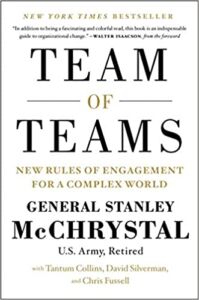 “Team of Teams: New Rules of Engagement for a Complex World” by General Stanley McChrystal is a book that explores how organizations can adapt and thrive in an increasingly complex and fast-changing world. Drawing on his experience as the commander of Joint Special Operations Task Force in Iraq, McChrystal shows how he transformed a hierarchical military organization into a flexible, adaptive team that could respond to the challenges posed by a decentralized and agile enemy.
“Team of Teams: New Rules of Engagement for a Complex World” by General Stanley McChrystal is a book that explores how organizations can adapt and thrive in an increasingly complex and fast-changing world. Drawing on his experience as the commander of Joint Special Operations Task Force in Iraq, McChrystal shows how he transformed a hierarchical military organization into a flexible, adaptive team that could respond to the challenges posed by a decentralized and agile enemy.
One of the key takeaways for business owners and leaders from this book is the importance of creating a shared consciousness among team members. McChrystal argues that in a complex environment, traditional top-down command-and-control structures are too slow and inflexible. Instead, teams must be empowered to make decisions at the front lines, based on a shared understanding of the organization’s goals, values, and priorities.
Another important lesson is the need for leaders to be humble and adaptable. McChrystal recounts how he had to let go of his traditional leadership style and learn to listen to and collaborate with his subordinates, who often had more specialized knowledge and expertise than he did. This kind of humility and openness to new ideas is essential for leaders who want to build effective teams in a rapidly changing world.
Finally, the book emphasizes the importance of continuous learning and improvement. McChrystal argues that organizations must be willing to experiment, take risks, and learn from their mistakes in order to stay ahead of the curve. This requires a culture of transparency, accountability, and continuous feedback, where everyone is encouraged to speak up and contribute to the team’s success.
Overall, “Team of Teams” offers a powerful model for how organizations can adapt and thrive in a complex and fast-changing world. By embracing principles of shared consciousness, humility, and continuous learning, business owners and leaders can build teams that are agile, innovative, and effective in achieving their goals.
Get “Team of Teams: New Rules of Engagement for a Complex World” here on Amazon.
How to Win Friends and Influence People
by Dale Carnegie
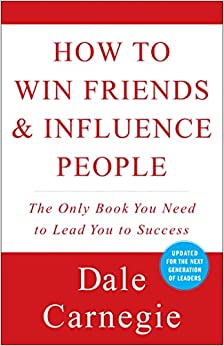 “How to Win Friends & Influence People” is a classic self-help book written by Dale Carnegie that was first published in 1936 and has sold over 30 million copies worldwide. The book provides practical advice on how to build strong relationships, communicate effectively, and achieve success in both personal and professional settings.
“How to Win Friends & Influence People” is a classic self-help book written by Dale Carnegie that was first published in 1936 and has sold over 30 million copies worldwide. The book provides practical advice on how to build strong relationships, communicate effectively, and achieve success in both personal and professional settings.
The key takeaways for business owners and leaders from this book are:
- Focus on building strong relationships: The book emphasizes the importance of building strong relationships with people by showing genuine interest in their lives, listening to them, and empathizing with them. Business owners and leaders can apply this principle by building strong relationships with their employees, customers, and partners, which can help them build trust, loyalty, and goodwill.
- Communication is key: The book highlights the importance of effective communication in building strong relationships and influencing people. Business owners and leaders can apply this principle by improving their communication skills, such as active listening, clear and concise messaging, and adapting communication styles to suit different audiences.
- Understand people’s needs and motivations: The book explains that understanding people’s needs and motivations is crucial in building strong relationships and influencing people. Business owners and leaders can apply this principle by understanding the needs and motivations of their employees, customers, and partners, and tailoring their communication and actions accordingly.
- Give honest and sincere appreciation: The book encourages giving honest and sincere appreciation to people, which can help build strong relationships and motivate people to perform better. Business owners and leaders can apply this principle by acknowledging and appreciating the efforts and achievements of their employees, customers, and partners.
Overall, “How to Win Friends & Influence People” is an essential read for business owners and leaders who want to improve their communication skills, build strong relationships, and achieve success in both their personal and professional lives. The book’s practical advice and timeless principles have stood the test of time and remain relevant even today.
Emotional Intelligence 2.0
by Travis Bradberry and Jean Greaves
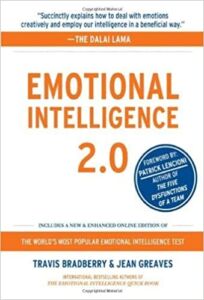 Before reading “Emotional Intelligence 2.0” by Travis Bradberry and Jean Greaves, I knew that emotional intelligence was important, but I didn’t fully understand how to use it to my advantage. This book delivers a step-by-step program for increasing my EQ via four core EQ skills that enable me to achieve my fullest potential.
Before reading “Emotional Intelligence 2.0” by Travis Bradberry and Jean Greaves, I knew that emotional intelligence was important, but I didn’t fully understand how to use it to my advantage. This book delivers a step-by-step program for increasing my EQ via four core EQ skills that enable me to achieve my fullest potential.
The first key takeaway for me as a business owner and leader is that EQ is crucial for success. Being able to recognize and manage my own emotions, as well as the emotions of others, is essential for effective leadership and team performance. By developing my EQ, I can create a positive work environment and foster effective communication and collaboration among team members.
The four key EQ skills – Self-Awareness, Self-Management, Social Awareness, and Relationship Management – were explained in detail, and I was given practical tips and exercises to improve my EQ in each area. The online assessment that accompanies the book helped me to measure my EQ score and identify areas where I need to improve.
One of the things I appreciated about this book was the authors’ recognition of common obstacles to improving EQ, such as stress, negative thinking, and lack of motivation. They provided strategies for overcoming these obstacles and emphasized that EQ is a skill that can be developed with practice and effort.
As a business owner and leader, I know that prioritizing my own EQ development can have a positive impact on my organization. By setting an example of emotional intelligence and creating a culture of EQ within my team, I can improve communication, increase collaboration, and drive better results.
In conclusion, “Emotional Intelligence 2.0” is a practical and valuable resource for business owners and leaders who want to improve their EQ and create a positive work environment. By following the step-by-step program and putting the tips and exercises into practice, I can increase my EQ and achieve greater success both personally and professionally.
Get “Emotional Intelligence 2.0” here on Amazon.
The Four Agreements: A Practical Guide to Personal Freedom
by Don Miguel Ruiz

At least twice a year, and sometimes more often than that, I re-read “The Four Agreements: A Practical Guide to Personal Freedom” by Don Miguel Ruiz. I highly recommend it to any business owner or leader looking to improve their personal and professional life. It is a short book, one that you could probably read in two hours or less, but the lessons are life-changing for me. I re-read it often because it is easy to forget the Four Agreements, but after I read this book, everything seems to make sense and be easier for a little while. Instead of getting mad at an employee or client, I remind myself, “Don’t take anything personally, Robert.” And when I beat myself up for not living up to my own expectations, I remind myself, “Did you do your best?”
The “Four Agreements” is mandatory reading for all new employees at Solano Law Firm and myself and Zaira have given this book to over 100 different team members, friends, and students. It embodies some of the most important core values that we strive for in our business, personal lives, and relationships. The Toltec wisdom offers four simple but powerful agreements that can help transform the way you interact with others and yourself.
The first agreement is to be impeccable with your word. This means speaking with integrity and only saying what you mean. By doing so, you can build trust and credibility with those around you, which can lead to better business relationships and improved team dynamics.
The second agreement is to not take anything personally. This is a critical agreement for business owners and leaders who face criticism and negative feedback on a regular basis. By recognizing that others’ opinions and actions are a reflection of their own beliefs and experiences, you can free yourself from unnecessary stress and conflict.
The third agreement is to not make assumptions. This agreement encourages you to ask questions and seek clarity instead of assuming you understand someone else’s perspective or intentions. By avoiding assumptions, you can avoid misunderstandings and conflicts, leading to more effective communication and collaboration.
The final agreement is to always do your best. This agreement is a reminder to strive for excellence in everything you do, even if you fall short at times. By doing your best, you can achieve personal and professional growth and gain a sense of satisfaction from knowing that you have given it your all.
Overall, “The Four Agreements” is an excellent book for business owners and leaders looking to improve their personal and professional relationships. By living these four agreements, you can cultivate a positive and fulfilling work environment and enhance your overall success.
You can get “The Four Agreements” here on Amazon.
The First 90 Days: Proven Strategies for Getting Up to Speed Faster and Smarter
As a supervisor who has frequently taken on new assignments and positions of responsibility, I highly recommend reading “The First 90 Days: Proven Strategies for Getting Up to Speed Faster and Smarter” by Michael D. Watkins. This book provides insightful and practical strategies for successfully navigating transitions and new roles, regardless of where you are in your career.
The author emphasizes that transitions are a critical time for leaders and that missteps made during the first three months can jeopardize or even derail success. Therefore, it’s essential to approach transitions with a strategic plan and a clear understanding of the challenges that lie ahead.
One key takeaway from the book is the importance of conducting a thorough assessment of the new role, organization, and team before taking any action. This step ensures that leaders have a clear understanding of the current situation, the organization’s culture, and the team’s strengths and weaknesses.
Another valuable strategy discussed in the book is the need to secure early wins. By identifying quick wins that align with the organization’s goals, leaders can build momentum and establish credibility with their team and stakeholders.
Finally, the author emphasizes the importance of building relationships and establishing a network of allies early on in the transition process. This network can provide valuable insights, support, and resources that can help leaders overcome challenges and achieve success.
I find myself re-reading this book whenever I am preparing for a new job or assignment. The practical strategies and insights provided in the book serve as a helpful guide for navigating the challenges of transitions and starting off on the right foot in a new role. Overall, I highly recommend this book to any business owner or leader looking to improve their transition process and achieve success in their new role.
You can get “The First 90 Days” here on Amazon.
The Big Leap: Conquer Your Hidden Fear and Take Life to the Next Level
by Gay Hendricks
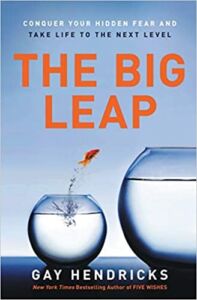 As someone who is preparing for a big transition from the military to starting my own business, I recently read “The Big Leap: Conquer Your Hidden Fear and Take Life to the Next Level” by Gay Hendricks, PhD, and it was a game changer for me. The book is all about overcoming our hidden fears and limiting beliefs to reach our full potential.
As someone who is preparing for a big transition from the military to starting my own business, I recently read “The Big Leap: Conquer Your Hidden Fear and Take Life to the Next Level” by Gay Hendricks, PhD, and it was a game changer for me. The book is all about overcoming our hidden fears and limiting beliefs to reach our full potential.
One of the key takeaways from the book is the concept of the Upper Limit Problem. Hendricks explains that many of us have an internal limit on how much happiness, success, and love we believe we can achieve. This limit is often rooted in our past experiences and conditioning. To break through this limit, we need to identify and challenge our limiting beliefs, and develop new habits and skills to support our growth.
Another important idea in the book is the Zone of Genius. Hendricks explains that when we operate in our Zone of Excellence, we are good at what we do, but we may not feel fulfilled. However, when we operate in our Zone of Genius, we tap into our unique abilities and passions, and experience a deep sense of purpose and fulfillment. As a business owner, this idea really resonated with me, and I started to think about how I could shift my focus to work more in my Zone of Genius.
I used the strategies and exercises in The Big Leap to prepare mentally for a big career transition from the military to launching my full-time coaching business. The book helped me to identify my limiting beliefs and fears, and gave me the tools to overcome them. I also learned how to tap into my Zone of Genius and align my business with my unique skills and passions.
Overall, I highly recommend “The Big Leap” to any business owner or leader who wants to break through their internal limits and reach their full potential. This book will challenge you to think differently about your capabilities and provide you with the tools to achieve your goals.
You can get “The Big Leap” here on Amazon.
Regenerate response
Traction: Get a Grip on Your Business
by Gino Wickman
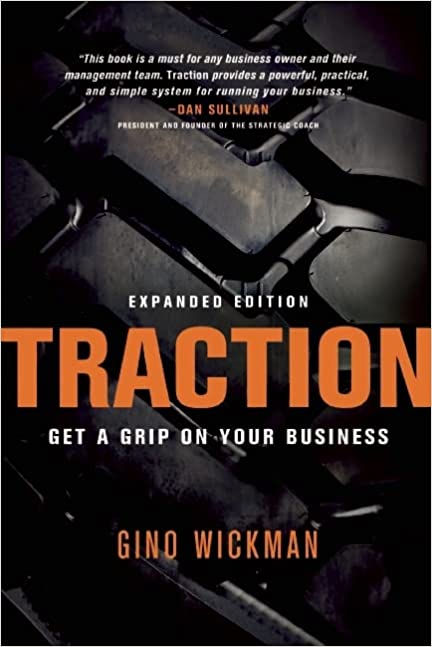 As a business owner and leader, I am always on the lookout for ways to improve my company’s performance and achieve success. In my search for leadership tactics and techniques, I stumbled upon the book “Traction” by Gino Wickman, and it has been a game changer for me and my team.
As a business owner and leader, I am always on the lookout for ways to improve my company’s performance and achieve success. In my search for leadership tactics and techniques, I stumbled upon the book “Traction” by Gino Wickman, and it has been a game changer for me and my team.
The book is centered around the Entrepreneurial Operating System (EOS), which is a practical method for achieving organizational success. The EOS model is comprised of six key components: vision, people, data, issues, process, and traction. These six elements work together to help business owners and leaders achieve their goals and create a strong, unified team.
The first component of the EOS model is vision. In order to succeed, a company must have a clear and compelling vision that inspires and motivates its employees. This vision must be communicated effectively to everyone in the organization, so that everyone is on the same page and working towards the same goal.
The second component of the EOS model is people. In order to achieve success, a company must have the right people in the right seats. This means hiring the right employees, placing them in the right positions, and giving them the support and training they need to succeed.
The third component of the EOS model is data. In order to make informed decisions, a company must have access to accurate and timely data. This includes financial data, as well as data on customer satisfaction, employee performance, and other key metrics.
The fourth component of the EOS model is issues. Every company will face challenges and obstacles, and it’s important to have a system in place for identifying and addressing these issues. The EOS model provides a framework for identifying and solving issues in a timely and effective manner.
The fifth component of the EOS model is process. In order to achieve consistent results, a company must have well-defined and documented processes in place. This includes everything from how work is done to how decisions are made.
The final component of the EOS model is traction. This refers to the ability of a company to execute its plans and achieve its goals. Traction requires discipline, focus, and accountability, and it’s something that every company needs in order to succeed.
I have found that the principles of Traction, specifically the EOS model, have become a core foundation of my business, Solano Law Firm, my government program office, and my future coaching business. The EOS model has been instrumental in helping me manage the human capital of small teams of 10 to 100 people, and it has helped me get everyone behind the same unified vision.
As a trained EOS implementor, I have been implementing EOS for years in my own business and others. I have found that the EOS model is one of the best techniques for managing the human capital of small teams, and it helps leaders get everyone behind the same unified vision.
In addition to the original “Traction” book, there are also several derivative books in the EOS library that provide more detailed information on specific aspects of the EOS model. For example, “What the Heck is EOS?” provides a high-level overview of the EOS model, while “How to Be a Great Boss” focuses specifically on leadership and management skills.
In conclusion, “Traction” is a must-read for any business owner or leader who wants to achieve success. The EOS model provides a practical and effective framework for achieving organizational success, and it has become a core foundation of my business and my coaching practice. I highly recommend this book to anyone who is looking for a way to improve their company’s performance and create a strong, unified team.
—stories, insights, and perspectives from my journey.
Ready to Explore Plant Medicines?
DON’T START YOUR JOURNEY WITHOUT THIS GUIDE
Download the free Psychedelic Transformation Framework™ Guide and discover the proven framework that ensures safe, breakthrough experiences for leaders who are ready to discover their awakened self.
